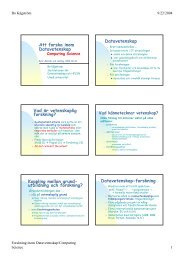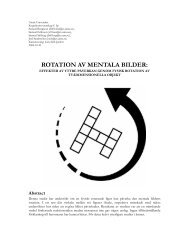Designing a persistent online strategy game - Department of ...
Designing a persistent online strategy game - Department of ...
Designing a persistent online strategy game - Department of ...
Create successful ePaper yourself
Turn your PDF publications into a flip-book with our unique Google optimized e-Paper software.
36 Chapter 4. Models & methods for evaluating <strong>game</strong>s<br />
or skiing. The more experienced you are the more choices you have to engage in greater<br />
challenges.<br />
4.6 Immersion<br />
Both players and researchers agree that immersion is an important quality when playing<br />
a <strong>game</strong>. Immersion is <strong>of</strong>ten used to refer to the degree <strong>of</strong> involvement or engagement one<br />
experiences with a <strong>game</strong> [25], but the exact definition varies between researchers and<br />
disciplines. Many players also have their own definition <strong>of</strong> immersion, so Brown & Cairns<br />
interviewed seven <strong>game</strong>rs in an attempt to define immersion [5]. They identified the<br />
three levels <strong>of</strong> immersion; engagement, engrossment and total immersion. Each<br />
level has a number <strong>of</strong> barriers associated with it. A player can not reach a particular<br />
level until all barriers for that level has been breached. Removing these barriers does<br />
not, however, guarantee that the player becomes immersed at that level; they are only<br />
preconditions for the experience. Below follow a description <strong>of</strong> the three levels and the<br />
barriers associated:<br />
Engagement. This is the first stage <strong>of</strong> immersion and must occur before any other<br />
stage. The barriers here are access and investment <strong>of</strong> time, effort and attention. Access<br />
relates to that the player must feel that she can control the <strong>game</strong> and know the actions<br />
and consequences. For a player to invest in a <strong>game</strong> she must first <strong>of</strong> all like the type <strong>of</strong><br />
<strong>game</strong>, if not she would not even try to engage in it. When these two barriers are down<br />
the player can feel engagement in a <strong>game</strong>, she is interested and wants to keep playing,<br />
but she is not yet emotionally involved in the <strong>game</strong>.<br />
Engrossment. Engagement can evolve into engrossment. The barrier here is <strong>game</strong><br />
construction. A good constructed <strong>game</strong> combines (among other) visuals, interesting<br />
tasks and plot in a way that the player’s emotions are directly affected by the <strong>game</strong>.<br />
The emotional involvement can make the player feel “emotionally drained” when they<br />
stop playing.<br />
Total immersion. In this level the player devotes all attention to the <strong>game</strong> and it<br />
feels as if she “is there”. What happens in the <strong>game</strong> is the only thing that occupies<br />
the player’s thoughts. The only problem is that this is only a fleeting experience. The<br />
barriers for total immersion are empathy and atmosphere. The player must be attached<br />
o the main character or team and must empathise with their situation. Atmosphere is<br />
created by the sound, plot and graphics <strong>of</strong> the <strong>game</strong>. These parts require attention, and<br />
the more attention a player invests, the more immersed she can feel. In the case <strong>of</strong> total<br />
immersion, these aspects also have to feel relevant to the player.<br />
One problem with this classification is that it excludes certain types <strong>of</strong> <strong>game</strong>s. To be<br />
totally immersed the <strong>game</strong> needs to have a story and characters that the player can<br />
sympathize with. Many <strong>game</strong>s do not have either a story or characters, or <strong>of</strong>fer them<br />
only as a background that do not affect <strong>game</strong>play, but the player can still feel totally<br />
immersed in the <strong>game</strong> [1]. Ermi & Mäyrä suggests that immersion is a multidimensional<br />
phenomena [17]. They have identified three different types <strong>of</strong> immersion; sensory,<br />
challenge-based and imaginative immersion.<br />
Sensory immersion relates to the audiovisual experience <strong>of</strong> a <strong>game</strong>. Good graphics<br />
and sound and a big screen easily overtakes impressions from the real world and the















